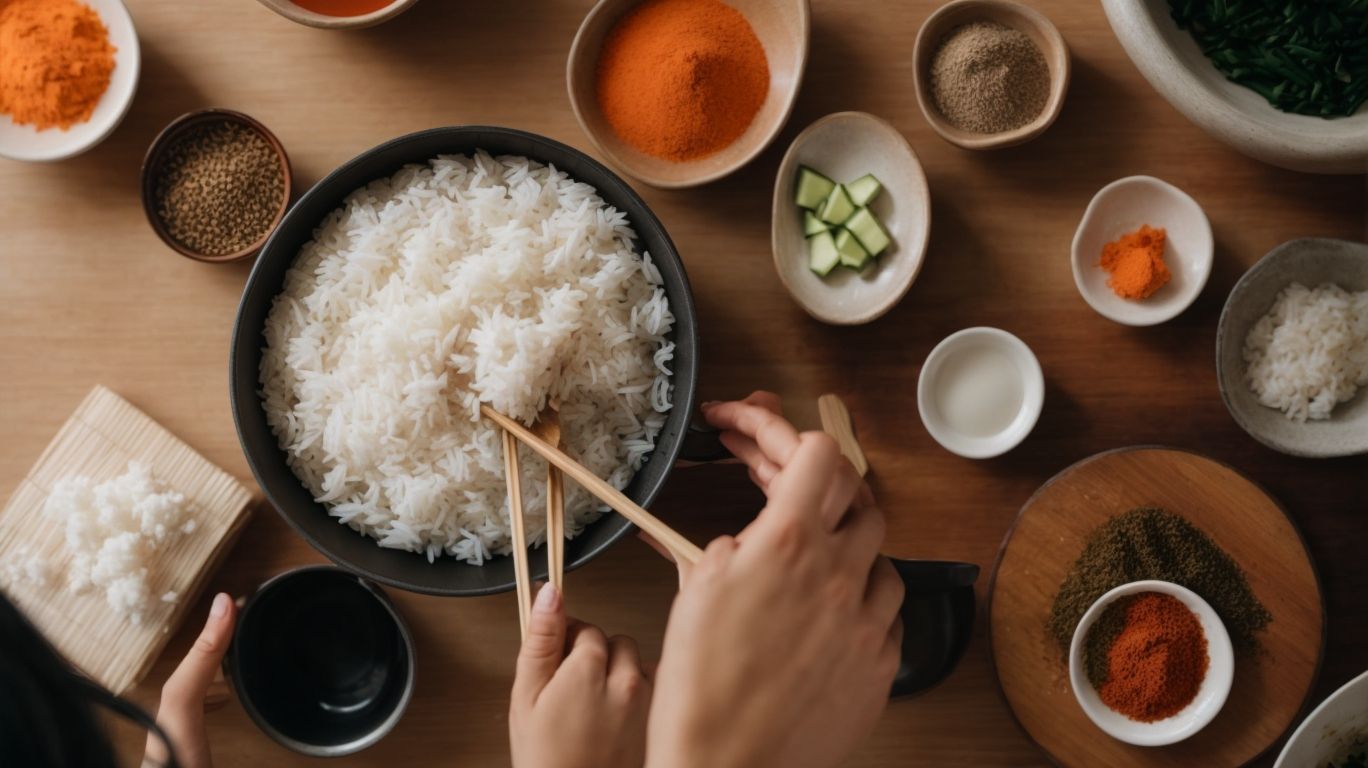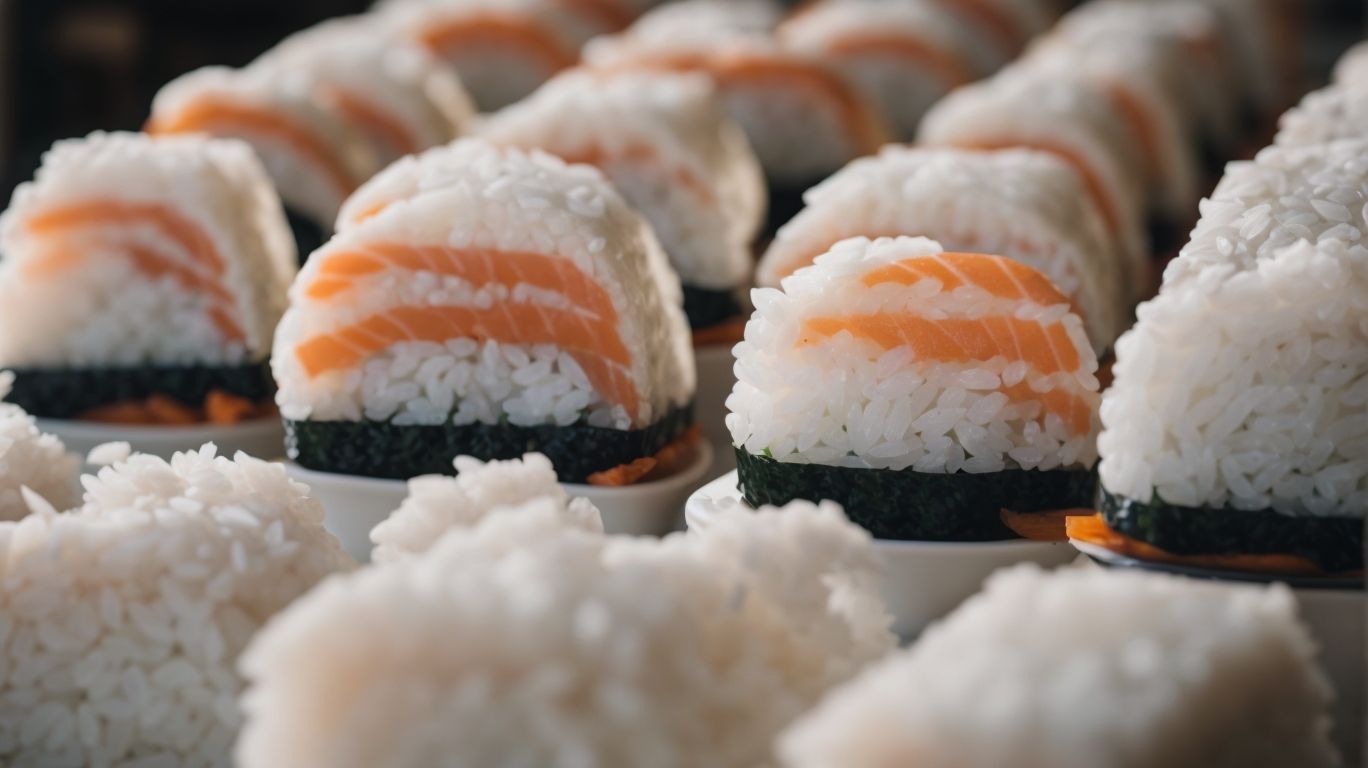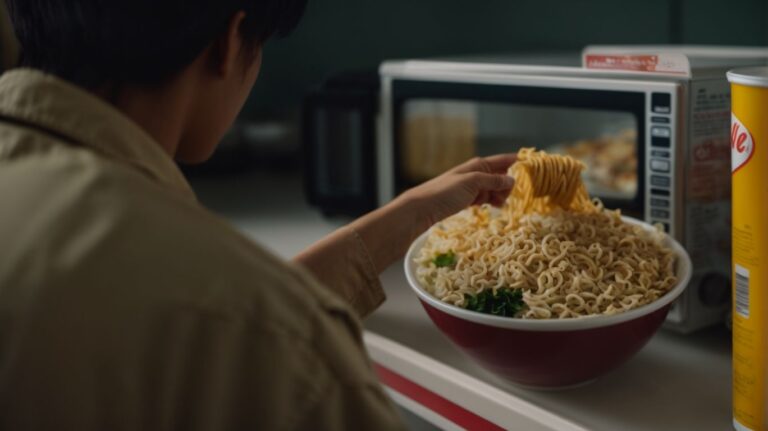How to Cook Rice for Sushi in Rice Cooker?
Are you a sushi lover looking to perfect your homemade sushi game?
We will guide you through the process of preparing sushi rice using a rice cooker.
From choosing the best type of rice to seasoning it with sushi vinegar, we’ve got you covered.
Stay tuned as we share tips on how to achieve the perfect texture and flavor for your sushi rice.
Let’s dive in and elevate your sushi-making skills!
Key Takeaways:
What is Sushi Rice?
Sushi rice, also known as Japanese-style short-grain white rice, is a staple ingredient in sushi preparation, renowned for its sticky texture and ability to hold seasonings.
Traditionally, sushi rice is seasoned with a mixture of rice vinegar, sugar, and salt, which gives it a distinct tangy flavor that complements the fresh seafood or vegetables used in sushi rolls.
Its short-grain variety is vital as it contains a higher starch content, resulting in the desired stickiness that allows the rice to hold together when shaped into sushi.
This stickiness not only helps in shaping the sushi but also enhances the overall eating experience, as each bite offers a satisfying chewiness that perfectly complements the fillings.
Why is Sushi Rice Important in Making Sushi?
Sushi rice plays a pivotal role in making sushi, as it serves as the foundation that binds together the various ingredients and imparts the essential flavors of the dish.
The sushi rice used in sushi-making is not just any rice; it is a carefully prepared blend of short-grain Japanese rice, vinegar, sugar, and salt. This unique combination is what gives sushi its distinct sticky texture and tangy flavor. The seasoning of the rice is crucial, as it not only enhances the taste but also acts as a preservative, allowing the sushi to be enjoyed fresh.
The stickiness of the rice is essential for shaping the sushi into its signature forms, such as rolls, nigiri, or sashimi. Without the proper texture and flavor of the rice, the entire sushi experience would fall flat.
It is this attention to detail in preparing and seasoning the sushi rice that elevates the dish from ordinary to extraordinary, making it a culinary delight appreciated worldwide.
Preparing the Rice for Sushi
Preparing the rice for sushi is a meticulous process that involves washing, soaking, and cooking the grains to achieve the perfect texture and consistency required for sushi-making.
What Type of Rice is Best for Sushi?
The best type of rice for sushi is Japanese-style short-grain white rice, renowned for its sticky texture and ability to hold seasonings, essential for authentic sushi dishes.
One of the main reasons why traditional short-grain Japanese rice is preferred for sushi-making is its high starch content, which contributes to the desired stickiness that allows the rice grains to hold together well when shaping sushi. This stickiness is vital for ensuring that the sushi rice holds its shape and binds the ingredients seamlessly, creating that characteristic sushi texture.
Plus its sticky nature, Japanese short-grain rice is prized for its ability to absorb flavors effectively, enhancing the overall taste of the sushi. Its balance of moisture and firmness ensures that the rice doesn’t become too mushy or dry when combined with the sushi vinegar seasoning.
When preparing sushi, the texture and consistency of the rice play a crucial role in determining the success of the dish. Japanese short-grain rice’s unique properties make it the ideal choice for achieving the authentic taste and texture that sushi enthusiasts crave.
How to Measure the Rice?
Measuring the rice for sushi accurately is crucial to achieving the perfect balance between the grains and water, ensuring the ideal texture and flavor in the final dish.
When preparing sushi rice, the rice-to-water ratio plays a vital role in determining the consistency and taste of the rice. A general rule of thumb is to use a 1:1.25 ratio, meaning for every cup of rice, you would add 1.25 cups of water. Some chefs prefer a slightly different ratio depending on the type of rice and personal taste preferences. It’s crucial to experiment and adjust the ratio based on your desired outcome to achieve that authentic sushi rice texture.
How to Rinse and Soak the Rice?
Rinsing and soaking the sushi rice are essential steps in the preparation process to remove excess starch and ensure proper hydration for ideal cooking and texture.
When rinsing the rice, it’s crucial to use cold water and gently agitate the grains. This helps to wash away the surface starch, giving the rice a cleaner taste and preventing it from becoming too sticky during cooking.
After rinsing, soaking the rice in water allows it to absorb moisture evenly, promoting uniform cooking and enhancing the overall flavor of your sushi. Remember to adjust the soaking time based on the specific type of rice you’re using to achieve the desired texture and consistency.
Cooking Sushi Rice in a Rice Cooker

Credits: Poormet.Com – Ethan Green
Cooking sushi rice in a rice cooker simplifies the process, allowing for precise water measurement and automated cooking to achieve consistent results with minimal effort.
What is a Rice Cooker and How Does it Work?
A rice cooker is a kitchen appliance designed to streamline the rice cooking process by automating temperature control, timing, and water absorption, ensuring consistent results every time.
With the push of a button, a rice cooker can handle everything from white rice, brown rice, jasmine rice, to even sushi rice, eliminating the guesswork and constantly monitoring the pot. These devices come in different sizes, some perfect for single servings while others cater to larger families. Utilizing a combination of heat and steam, rice cookers cook the grains evenly without the risk of burning or sticking to the bottom of the pot.
Most modern rice cookers offer convenient features like a keep-warm function that maintains the rice’s temperature without overcooking it, making it ideal for busy households. Cleaning is also a breeze as many models come with removable, dishwasher-safe components, saving time and effort in the kitchen.
How to Use a Rice Cooker to Cook Sushi Rice?
Using a rice cooker to cook sushi rice involves following specific water-to-rice ratios, selecting the appropriate settings, and allowing the cooker to steam the rice to perfection.
To start, for every cup of sushi rice you use, you typically need around 1.25 cups of water. This ratio is crucial in ensuring that the rice turns out neither too dry nor too mushy. Once you’ve measured the rice and water, rinse the rice thoroughly until the water runs clear to remove excess starch.
Next, add the rinsed rice and water to the rice cooker, stir gently, and let it sit for about 30 minutes to allow for absorption.
After the soaking stage, close the lid of the rice cooker and select the ‘Sushi’ or ‘White Rice’ setting, if available. These settings are tailored to cook the rice to the ideal consistency needed for sushi making. The rice cooker will then handle the cooking process and automatically shift to the warm setting when done.
What is the Ideal Rice to Water Ratio for Sushi Rice in a Rice Cooker?
The ideal rice-to-water ratio for sushi rice in a rice cooker is crucial for achieving the perfect texture and consistency, typically ranging from 1:1 to 1:1.25 depending on the rice variety and desired stickiness.
Choosing the right rice-to-water ratio can make or break your sushi rice. Too much water, and your rice may turn out mushy; too little, and it could end up too dry. For that perfectly sticky yet individual-grain consistency, opt for a 1:1 ratio for short-grain rice favored in sushi preparation. This ratio ensures that the rice grains cook evenly and cling together just right.
Seasoning the Sushi Rice

Credits: Poormet.Com – Adam Brown
Seasoning the sushi rice involves a delicate balance of rice vinegar, sugar, and fine sea salt to enhance the flavor profile, achieve the perfect acidity, and complement the sushi ingredients.
What is Sushi Vinegar and How to Make it?
Sushi vinegar is a specialized seasoning made from rice vinegar, sugar, and salt, carefully crafted to impart a distinct tangy flavor and sticky texture to sushi rice.
The key to perfecting sushi vinegar lies in getting the proportions just right. For every cup of rice vinegar, you typically use 1/4 cup of sugar and 1 teaspoon of salt. These ingredients are then gently heated in a saucepan over low heat, stirring continuously until the sugar and salt completely dissolve. Once cooled, this mixture is poured over freshly cooked rice and meticulously folded in with a flat wooden paddle in a cutting motion to evenly distribute the seasoning without mashing the grains.
How to Mix the Sushi Vinegar with the Cooked Rice?
Mixing the sushi vinegar with the cooked rice involves a gentle folding technique to ensure even distribution of flavors and seasonings without crushing the delicate grains.
When incorporating sushi vinegar into the rice, it is crucial to use a wooden or plastic rice paddle to prevent metal reactions that might alter the taste. The key is to pour the sushi vinegar evenly over the rice and then gently fold it in with a cutting and lifting motion. This method helps the rice absorb the tangy vinegar without becoming mushy. Remember to let the rice cool slightly before adding the vinegar to maintain the optimal texture and taste.
Tips for Making Perfect Sushi Rice in a Rice Cooker
Achieving perfect sushi rice in a rice cooker requires attention to detail, such as proper water measurement, precise seasoning, and gentle mixing techniques to ensure a flawless texture and flavor.
How to Prevent the Rice from Sticking to the Bottom of the Rice Cooker?
Preventing the rice from sticking to the bottom of the rice cooker involves using a well-seasoned hangiri or bowl, ensuring the rice is properly fluffed, and avoiding excessive stirring during the cooking process.
Proper seasoning of the hangiri or bowl before adding the rice is crucial; a light coating of oil or a sprinkle of salt can do wonders. When the rice is cooked, let it sit covered for a few minutes before gently fluffing it with a fork to separate the grains. It’s vital to resist the temptation to stir the rice too often as this can make it sticky. Simply let it cook, untouched, to ensure a perfect, fluffy batch of rice.”
How to Keep the Rice Moist and Fluffy?
Maintaining the moisture and fluffiness of sushi rice involves using the right water-to-rice ratio, incorporating kombu during cooking, and storing the rice properly after preparation to preserve its texture.
Ensuring the ideal water proportion is crucial; typically, opting for a 1:1.1 ratio of water to rice can help achieve the desired consistency. Kombu infusion, a technique where seaweed is added during cooking, not only enhances flavor but also adds moisture to the grains. Once the rice is cooked, removing the kombu prevents over-absorption of liquid. Proper storage is key to retaining freshness; storing sushi rice in a damp cloth-covered container at room temperature helps prevent dryness and maintains its optimal texture for sushi dishes.
How to Cool Down the Rice Quickly?
Cooling down sushi rice rapidly is essential for preserving its texture and preventing overcooking, achieved by transferring the rice to a hangiri or shallow container for efficient cooling.
“
Once the rice is placed in the wide container, fanning should be done gently over the rice surface. This aids in evaporation, reducing the temperature quickly. Mixing the rice occasionally helps in the heat distribution, ensuring that all parts cool at a similar rate. Experts recommend avoiding compacting the rice during this process as it could lead to uneven cooling. By following these steps diligently, you can ensure that your sushi rice retains its signature sticky yet separate grains texture, perfect for delicious sushi creations.
Frequently Asked Questions
1. How do I cook rice for sushi in a rice cooker?
To cook rice for sushi in a rice cooker, start by rinsing the rice until the water runs clear. Then, add the rice and water to the rice cooker and turn it on. Let it cook for the specified time according to your rice cooker’s instructions.
2. What type of rice is best for making sushi in a rice cooker?
Short-grain Japanese rice is the best type of rice for making sushi in a rice cooker. It has the perfect texture and stickiness for sushi rolls.
3. Can I add seasoning to the rice when cooking it for sushi?
Yes, you can add a seasoned vinegar mixture to the rice before cooking it in the rice cooker. This will give the rice a slightly sweet and tangy flavor, perfect for sushi.
4. How much water should I use when cooking rice for sushi in a rice cooker?
The general rule for cooking sushi rice in a rice cooker is to use 1 1/4 cups of water for every 1 cup of rice. However, the amount of water may vary depending on the type of rice and your personal preference.
5. Can I use a regular rice cooker to make sushi rice?
Yes, you can use a regular rice cooker to make sushi rice. Just make sure it has a sushi rice setting or use the regular white rice setting if it does not have a specific setting for sushi rice.
6. How long does it take to cook sushi rice in a rice cooker?
The cooking time for sushi rice in a rice cooker can vary from 20-30 minutes, depending on the type of rice and your rice cooker’s instructions. It’s best to follow the suggested cooking time on your rice cooker for the best results.






